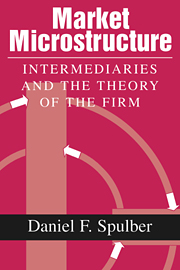Book contents
- Frontmatter
- Contents
- Preface and acknowledgments
- Introduction
- Part I Market microstructure and the intermediation theory of the firm
- Part II Competition and market equilibrium
- Part III Intermediation versus decentralized trade
- Part IV Intermediation under asymmetric information
- 7 Adverse selection in product markets
- 8 Adverse selection in financial markets
- Part V Intermediation and transaction-cost theory
- Part VI Intermediation and agency theory
- Conclusion
- References
- Index
7 - Adverse selection in product markets
Published online by Cambridge University Press: 18 December 2009
- Frontmatter
- Contents
- Preface and acknowledgments
- Introduction
- Part I Market microstructure and the intermediation theory of the firm
- Part II Competition and market equilibrium
- Part III Intermediation versus decentralized trade
- Part IV Intermediation under asymmetric information
- 7 Adverse selection in product markets
- 8 Adverse selection in financial markets
- Part V Intermediation and transaction-cost theory
- Part VI Intermediation and agency theory
- Conclusion
- References
- Index
Summary
This chapter considers allocation of goods by intermediaries under asymmetric information. Consumers have private information about their willingness to pay for the good. Suppliers have private information about their opportunity costs. This creates information asymmetries that complicate the process of exchange between consumers and suppliers as well as supplier production decisions. Incomplete information creates a role for intermediaries as designers of trading mechanisms that give consumers and suppliers incentives to reveal their private information.
Intermediaries generally are subject to the same information asymmetries as buyers and sellers. They do not know consumer willingness-to-pay levels or supplier opportunity costs. However, intermediaries have a number of potential advantages over other market participants. The intermediary can achieve cost advantages from specialization as a mechanism designer. Intermediaries can gather additional information by dealing with multiple buyers and sellers. Also, intermediaries have greater latitude in the design of mechanisms as they can tax or subsidize individual transactions, since they are not subject to the implicit budget balancing that direct exchange requires.
To address basic exchange under asymmetric information, I begin in Section 7.1 with the basic intermediated bargaining model of Myerson and Satterthwaite (1983). In the model, an intermediary designs a trading mechanism for a buyer and a seller who are exchanging a single object. By the revelation principle, a direct mechanism can represent the outcomes of bargaining under asymmetric information. The direct mechanism determines the payment and the likelihood of trade given the announcements by the buyer and the seller of their respective private information.
- Type
- Chapter
- Information
- Market MicrostructureIntermediaries and the Theory of the Firm, pp. 171 - 202Publisher: Cambridge University PressPrint publication year: 1999



